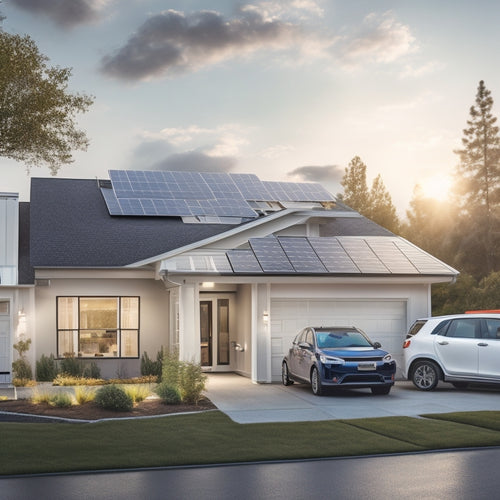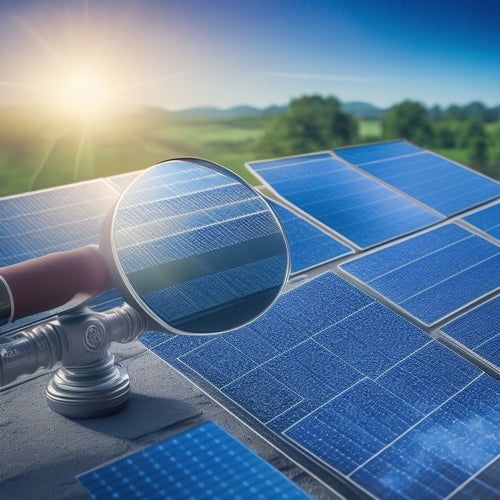
What Are the Benefits of Combining Solar Power and Battery Storage
Share
By combining solar power and battery storage, you can reveal a thorough energy solution that mitigates reliance on the grid, reduces electricity bills, and supports a sustainable future. You'll enjoy increased energy independence, reduced electricity bills, and improved power quality. Additionally, you'll contribute to enhanced grid resilience, a smaller carbon footprint, and extended backup power during outages. With this combo, you'll also reduce peak demand charges and potentially increase your property value. As you investigate the benefits of solar power and battery storage, you'll uncover a customized approach to energy management that can alter your relationship with energy consumption.
Key Takeaways
- Combining solar power and battery storage increases energy independence, allowing homeowners to rely less on the grid and reduce their carbon footprint.
- This combination reduces electricity bills by utilizing excess energy generated during the day and storing it for nighttime or cloudy day use.
- It also improves power quality by regulating voltage, protecting appliances from damage, and enhancing efficiency.
- The integration of solar power and battery storage enhances grid resilience by reducing peak demand and providing stable voltage support.
- It provides extended backup power during outages, ensuring essential appliances remain powered and daily routines are uninterrupted.
Increased Energy Independence
Tapping into solar power and battery storage enables homeowners to break free from reliance on the grid, granting them increased energy independence. You'll be less dependent on external energy sources, ensuring a more stable and secure energy supply.
This integration of technology also paves the way for a sustainable future, where renewable resources are utilized to power your home. As a result, you'll be contributing to climate action and reducing your carbon footprint.
With energy storage, you can store excess energy generated during the day for use during the night or on cloudy days. This technology integration enables smart homes to optimize energy usage, reducing the strain on the grid and promoting grid modernization.
Community initiatives and energy policies are also driving the adoption of solar power and battery storage, further solidifying its importance in achieving economic stability. By adopting this technology, you'll be part of a movement that's shaping a more sustainable future for generations to come.
Reduced Electricity Bills
By leveraging solar power and battery storage, you'll considerably reduce your reliance on the grid, which translates to lower electricity bills. This is because you'll be generating your own clean energy during the day and storing excess energy in your battery for later use. As a result, you'll be drawing less power from the grid, reducing your overall energy consumption and saving money on your electricity bills.
Additionally, many governments offer solar incentives to encourage homeowners and businesses to switch to renewable energy sources. These incentives can help offset the initial cost of installing solar power and battery storage systems, making them more accessible and affordable.
Improved Power Quality
You'll notice a significant improvement in power quality when you combine solar power with battery storage.
This is because voltage regulation matters, ensuring a stable and consistent output that protects your appliances from damage.
Voltage Regulation Matters
Voltage Regulation Matters (Improved Power Quality)
When you combine solar power and battery storage, you'll notice a significant improvement in your power quality. One key aspect of this improvement is voltage regulation.
You see, voltage stability is essential for ensuring your appliances and equipment function efficiently. Without it, you may experience frequent shutdowns, reduced lifespan, or even complete system failure. By integrating battery storage with your solar power system, you'll enjoy a more stable voltage output. This means your devices will operate within their ideal voltage range, resulting in improved energy efficiency.
In addition, voltage regulation helps mitigate issues like voltage sags, swells, and spikes. These disturbances can damage your equipment or cause data loss.
With a solar power and battery storage system, you'll have a buffer against such fluctuations, ensuring your loads remain protected. By maintaining a stable voltage output, you'll reduce the risk of equipment failure, downtime, and costly repairs. This, in turn, leads to increased productivity, reliability, and overall system performance.
Cleaner Power Output
Generating clean power output is a critical aspect of ensuring improved power quality, and integrating solar power with battery storage takes it to the next level. When you combine these two technologies, you can expect a significant reduction in power fluctuations and disturbances. This results in a cleaner power output that's more stable and reliable.
Here's what you can expect from integrating solar power and battery storage:
-
Improved solar efficiency: With battery storage, you can store excess energy generated by your solar panels during the day and use it at night, reducing energy waste and increasing overall solar efficiency.
-
Reduced power fluctuations: Battery storage helps to smooth out power fluctuations, providing a more consistent and stable energy supply.
-
Increased battery longevity: By reducing the number of charge and discharge cycles, you can extend the lifespan of your batteries, saving you money in the long run.
- Enhanced overall system reliability: With a combined solar power and battery storage system, you can enjoy a more reliable energy supply, even during grid outages or extreme weather conditions.
Reduced Harmonic Distortion
Most solar power systems exhibit some degree of harmonic distortion, which can negatively impact power quality and even damage sensitive electronics.
When you combine solar power with battery storage, you can greatly reduce harmonic distortion, ensuring a cleaner and more reliable power output.
By integrating a battery storage system, you can perform harmonic analysis to identify and mitigate distortion in your solar power output. This is particularly important for commercial or industrial applications, where sensitive equipment requires high-quality power to function efficiently.
Distortion mitigation is essential to prevent overheating, motor failures, and other issues that can lead to costly downtime and repairs.
With a battery storage system, you can filter out unwanted harmonics, ensuring that your power output is stable and reliable. This results in a notable improvement in power quality, making it ideal for applications that require precise voltage and frequency control.
Enhanced Grid Resilience
With solar power and battery storage, you're not only reducing your reliance on the grid but also contributing to its overall stability.
By integrating solar power into the grid, you're creating a renewable collaboration that enhances energy security and supports sustainable infrastructure. This collaboration also enables disaster preparedness and community resilience, ensuring that your community remains powered during outages.
Here are some ways solar power and battery storage enhance grid resilience:
- Peak shaving: Reducing peak demand on the grid during periods of high energy usage.
- Frequency regulation: Stabilizing the grid frequency to prevent brownouts and blackouts.
- Voltage support: Maintaining a stable voltage level to prevent equipment damage.
- Islanding: Enabling your system to operate independently during grid outages, providing a reliable source of power.
Smaller Carbon Footprint
As you shift to solar power and battery storage, your carbon footprint undergoes a significant reduction, creating a more environmentally friendly energy profile. By utilizing renewable energy from the sun, you're reducing your reliance on fossil fuels and lower your environmental impact. This change to eco-friendly practices not only benefits the planet but also contributes to a sustainable living future.
| Benefit | Description | Impact |
|---|---|---|
| Reduced Carbon Emissions | Lower greenhouse gas emissions from energy generation | 60-70% reduction in carbon footprint |
| Renewable Energy Source | Solar power provides a clean and sustainable energy source | 100% renewable energy generation |
| Energy Conservation | Optimized energy usage through battery storage | Up to 90% energy self-sufficiency |
Extended Backup Power
Hooked up to a solar power system with battery storage, you're equipped to ride out power outages with extended backup power. This means you can maintain your daily routine and prioritize emergency preparedness without worrying about the grid's reliability.
With a sustainable lifestyle in mind, you'll have peace of mind knowing you can power essential appliances and devices during extended outages.
Here are some scenarios where extended backup power comes in handy:
-
Keep the lights on: Power your home's lighting, guaranteeing safety and visibility during the night.
-
Stay connected: Keep your phone, laptop, and other essential devices charged and connected to the world.
-
Preserve food: Run your refrigerator and freezer to keep your food from spoiling.
- Maintain medical equipment: Power critical medical devices, such as oxygen concentrators or dialysis machines, to guarantee the well-being of yourself or loved ones.
Reduced Peak Demand Charges
By integrating solar power and battery storage, you can optimize your energy consumption patterns to reduce peak demand charges.
This is achieved by shifting peak usage times to when energy is being generated or stored, rather than relying on the grid during peak hours.
Optimizing Energy Consumption Patterns
You can considerably reduce your peak demand charges by optimizing your energy consumption patterns. By doing so, you'll be able to better manage your energy usage and reduce your reliance on the grid during peak hours.
This is especially important for commercial and industrial customers, as peak demand charges can account for a notable portion of their energy bills.
Here are some ways you can optimize your energy consumption patterns:
-
Schedule energy-intensive tasks: Run high-energy appliances like dishwashers, washing machines, and dryers during off-peak hours when energy demand is lower.
-
Implement energy-efficient lighting: Replace traditional lighting with LED bulbs, which use considerably less energy and last longer.
-
Use power strips: Plug your electronics, such as TVs and computers, into power strips and turn off the strip when they're not in use to eliminate standby power consumption.
- Participate in demand response programs: Work with your utility company to reduce energy consumption during peak hours in exchange for incentives or rebates.
Shift Peak Usage Times
Time-of-use (TOU) rates, which charge higher rates during peak hours, can be a significant burden on your energy budget. By combining solar power and battery storage, you can shift your peak usage times and reduce your peak demand charges. This strategy, known as peak shaving, involves storing excess energy generated by your solar panels during the day and using it during peak hours when energy rates are highest.
| Peak Shaving Strategies | Benefits |
|---|---|
| Load Shifting | Shift non-essential loads to off-peak hours, reducing peak demand |
| Energy Arbitrage | Store energy during off-peak hours and sell it back to the grid during peak hours |
| Demand Response | Reduce energy consumption during peak hours in response to high energy rates |
| Consumption Forecasting | Predict energy usage patterns and adjust energy storage accordingly |
| Grid Balancing | Help stabilize the grid by reducing peak energy demand |
Increased Property Value
Several studies have consistently shown that installing solar power and battery storage systems can greatly enhance your property's value. This increase in value isn't just a minor bump; it can have a considerable impact on your property's selling price.
In fact, according to the National Renewable Energy Laboratory, homes with solar panels sell for an average of $15,000 more than similar homes without them.
Here's how solar power and battery storage can increase your property's value:
-
Increased appeal to eco-conscious buyers: Many homebuyers are looking for properties with sustainable features, and solar power and battery storage systems are highly desirable.
-
Reduced energy costs: With solar power and battery storage, you can considerably reduce your energy bills, making your property more attractive to potential buyers.
-
Enhanced property market trends: As the demand for sustainable energy solutions grows, properties with solar power and battery storage systems are becoming more sought after.
- Alignment with homebuyer preferences: By installing solar power and battery storage systems, you're catering to the growing number of homebuyers who prioritize energy efficiency and sustainability.
Frequently Asked Questions
Can I Use Solar Power and Battery Storage With My Existing Electrical System?
You can integrate solar power and battery storage with your existing electrical system, but first, assess system compatibility and investigate installation options, ensuring a seamless connection that meets your energy needs and local building codes.
How Long Does It Take to Install a Solar Power and Battery Storage System?
"Will you be waiting for weeks to utilize the power of the sun? Not likely! You'll typically spend around 2-5 days on installation, depending on the complexity of your system components, and can enjoy a streamlined installation timeline with a skilled team.
Are Solar Power and Battery Storage Systems Eligible for Government Incentives?
You're likely eligible for government incentives, which can greatly offset the cost of your solar power and battery storage system, resulting in substantial financial savings and a faster return on your investment.
Can I Monitor and Control My Solar Power and Battery Storage Remotely?
You can easily monitor and control your solar power and battery storage remotely, leveraging advanced energy management systems to track performance, optimize energy usage, and receive real-time updates on your system's status.
What Kind of Maintenance Is Required for Solar Power and Battery Storage Systems?
As you bask in the clean energy glow, you'll want to guarantee your solar power and battery storage system stays optimized; regular checks on connections, battery health, and software updates will enhance system longevity and performance optimization, giving you peace of mind.
Conclusion
By combining solar power and battery storage, you're not just generating electricity, you're utilizing the power of the sun and storing it for a rainy day - literally. With this energetic duo, you'll enjoy a heightened sense of energy independence, slashed electricity bills, and a markedly reduced carbon footprint. It's a match made in heaven, and the benefits are simply electrifying.
Related Posts
-

What Electric Vehicle Owners Need for Home Energy
As an electric vehicle owner, you need to optimize your home energy system to guarantee efficient, sustainable, and c...
-

Solar Panel System Certification Costs: A 10-Point Breakdown
You're looking to understand the costs associated with solar panel system certification. Your total certification cos...
-

Why Electric Motorcycles Fail at Long-Distance Touring
You're likely familiar with the excitement of hitting the open road on an electric motorcycle, but you're also smart ...


